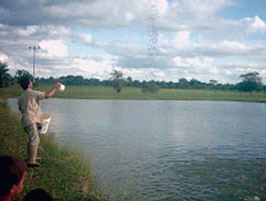Use of the feeding table to improve productivity in the cultivation of cachama
Abstract
The main objective of the fish farming activity is the production of a source of protein of animal origin for human consumption, by increasing the weight of the fish in the shortest possible time, allowing their breeding to be economically profitable. For this purpose, among other relevant factors, a feeding program should be considered, which also covers the nutritional requirements of the organism that is cultivated, in this case, the cachama.
One of the practices that support the feeding program consists of the application of a fertilization plan, which is based on the incorporation of nutrients to the water of the lagoons, to promote plankton as a food source, which will contribute to nourish the cachama fingerlings, during the first phase of their rearing.
However, during the cachama growth process, the supply of concentrated food is necessary, above all, in those crops with intensive characteristics for this species, so its future expansion will be mainly supported by supplementation of concentrated food with medium levels of protein and of excellent quality.
That is why an efficient feeding program should be proposed in accordance with the needs of the fish, since it represents between 60-70% of the costs, which warrants proper management of it (Carbonell et al., 2013).
In this sense, a feeding table has been designed, as a tool that facilitates the calculation of the appropriate amounts of concentrated feed, in the precise time for it, all this in function of helping the producer to keep a record that allows him reduce operating expenses and ultimately really appreciate profitability margins.
For this purpose, some basic concepts must be taken into consideration to guarantee the success of said cachama feeding program, such as: the type of food, nutritional requirements, quantities and frequency of food supply, among others.
References
Giménez, C. 1995 Actualidad y perspectivas de la Acuicultura en Venezuela Memorias del III Encuentro Nacional de Acuicultura. San Cristóbal, Edo Táchira. 70 p.
Gonzáles, J. y B. Heredia. 1998. El cultivo de la cachama (Colossoma macrospomum). Maracay, Venezuela FONAIAP. CIAE-Guárico, Estación Experimental Guanapito. 124 p.
González, R. 1989. Tecnología de la reproducción de la Cachama (Piaractus brachypomus y Colossoma macropomum). Memorias segundo curso Cultivo de Cachama. INDERENA Regional Llanos Orientales. Villavicencio.


